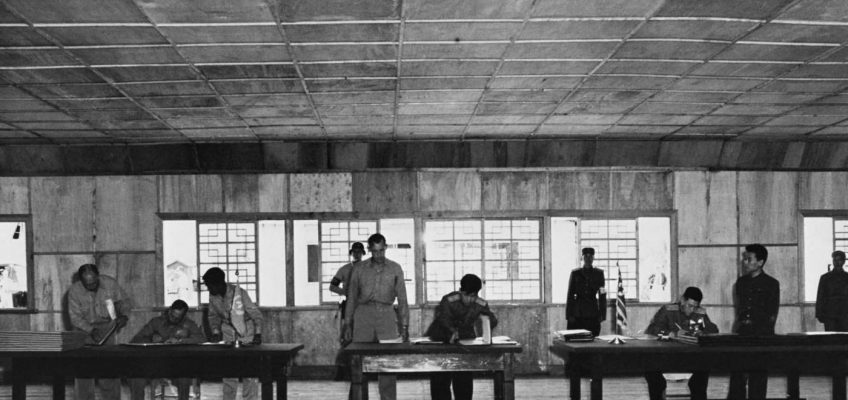Today is Sunday, July 27, the 208th day of 2025. There are 157 days left in the year.
Today in history:
On July 27, 1953, the Korean Armistice Agreement was signed at Panmunjom, ending three years of fighting on the Korean peninsula that killed an estimated 4 million people.
Also on this date:
In 1789, President George Washington signed a measure establishing the Department of Foreign Affairs, forerunner of the Department of State.
Related Articles
A man accused of stabbing 11 people at a Walmart is in Michigan authorities’ custody
Today in History: July 26, Americans with Disabilities Act signed into law
Paramount gets green light for $8 billion merger. But what is the psychic cost for company?
Southwest Airlines flight headed to Las Vegas takes dramatic plunge in response to nearby aircraft
Hulk Hogan’s death resurfaces painful contradictions for Black wrestling fans
In 1866, Cyrus W. Field finished laying out the first successful underwater telegraph cable between North America and Europe.
In 1909, during the first official test of the U.S. Army’s first airplane, Orville Wright flew himself and a passenger, Lt. Frank Lahm, above Fort Myer, Virginia, for one hour and 12 minutes.
In 1940, Billboard magazine published its first “music popularity chart” listing best-selling retail records. In first place was “I’ll Never Smile Again” recorded by Tommy Dorsey and His Orchestra, with featured vocalist Frank Sinatra.
In 1974, the House Judiciary Committee voted 27-11 to adopt the first of three articles of impeachment against President Richard Nixon, charging he had personally engaged in a course of conduct designed to obstruct justice in the Watergate case.
In 1980, on day 267 of the Iranian hostage crisis, the deposed Shah of Iran died at a military hospital outside Cairo, Egypt, at age 60.
In 1981, 6-year-old Adam Walsh was abducted from a department store in Hollywood, Fla., and was later murdered (Adam’s father, John Walsh, subsequently became a victims’ rights activist and, in 1988, launched and hosted the television show “America’s Most Wanted”).
In 1996, terror struck the Atlanta Olympics as a pipe bomb exploded at Centennial Olympic Park, directly killing one person and injuring 111. (Anti-government extremist Eric Rudolph later pleaded guilty to the bombing, exonerating security guard Richard Jewell, who had been wrongly suspected.)
In 2012, Britain opened its Olympic Games in a celebration of Old England and new, even cheekily featuring stunt doubles for Queen Elizabeth II and fictional special agent James Bond parachuting into Olympic Stadium.
In 2013, security forces and armed men clashed with supporters of Egypt’s ousted president, Mohammed Morsi, killing at least 72 people.
In 2015, the Boy Scouts of America ended its blanket ban on gay adult leaders while allowing church-sponsored Scout units to maintain the exclusion for religious reasons.
In 2018, the White House announced that North Korea had returned the remains of what were believed to be U.S. servicemen killed during the Korean War, with a U.S. military plane making a rare trip into North Korea to retrieve 55 cases of remains.
In 2020, the world’s biggest COVID-19 vaccine study began with the first of 30,000 planned volunteers helping to test shots created by the National Institutes of Health and Moderna Inc.
In 2021, American gymnast Simone Biles pulled out of the gymnastics team competition at the Tokyo Olympics to focus on her mental well-being, saying she realized following a shaky vault that she wasn’t in the right headspace to compete.
Today’s Birthdays:
Singer-songwriter Bobbie Gentry is 83.
Actor-director Betty Thomas is 78.
Olympic gold medal figure skater Peggy Fleming is 77.
Singer Maureen McGovern is 76.
Comedian-actor-writer Carol Leifer is 69.
Comedian Bill Engvall is 68.
Actor-martial artist Donnie Yen is 62.
Jazz singer Karrin Allyson is 62.
Rock musician Juliana Hatfield is 58.
Former professional wrestler Triple H is 56.
Actor Nikolaj Coster-Waldau (NIH’-koh-lye KAH’-stur WAHL’-dah) is 55.
Comedian Maya Rudolph is 53.
Rock musician Abe Cunningham (Deftones) is 52.
Singer-songwriter Pete Yorn is 51.
Former MLB All-Star Alex Rodriguez is 50.
Actor Jonathan Rhys (rees) Meyers is 48.
Actor/comedian Heidi Gardner (TV: “Saturday Night Live”) is 42.
Actor Taylor Schilling is 41.
MLB All-Star pitcher Max Scherzer is 41.
Golfer Jordan Spieth is 32.




